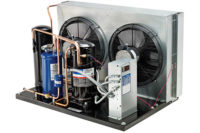These were just some of the directions technical papers took at the most recent International Institute of Ammonia Refrigeration Industrial Conference.
Here is a brief summary of three such papers, all quotes taken directly from the papers.
MICROCHANNEL
In a paper titled “Application of Micro-channel Heat Exchangers to Compact Ammonia Systems,” Mark Tomooka of Mayekawa USA noted, “Ammonia has many favorable characteristics that make it the refrigerant of choice for high-efficiency systems. However, these systems are typically used for food refrigeration, cold storage warehousing, and process cooling, but seldom are considered in applications where small charge and equipment size are a factor. Additionally, since ammonia refrigeration components are typically industrial grade, cost prevents wider use in commercial and chiller applications.”Enter microchannel.
“Microchannel heat exchangers (MCHX) and hermetic compressors are examples of technology that can make ammonia refrigeration more attractive in applications typically dominated by synthetic refrigerants. These technologies retain their high-efficiency characteristics and ally them with creative solutions that have prevented more widespread use. It also has the advantage of directly responding to the challenges facing refrigeration.”
He went on to note, “Microchannel heat exchangers allow for larger heat exchange surfaces in smaller packages. Tests show that compared to a round tube/plate fin condenser, a microchannel air-cooled condenser would be 14 times lighter, and would have 20 percent of the volume, 25 percent of the charge, and 60 percent of the pressure drop on the air-side. Applying micro-channel technology to ammonia refrigeration systems reduces system charge. Additional benefits are gained by using scroll compressors, which allow for a smaller equipment footprint and lower weight. Energy savings are also realized due to lower fan horsepower required for the microchannel condenser.”
HIGH-RISE
In a paper titled “Refrigeration Implications of High-Rise Automated Warehouses” by Gerald von Dohlen of Newark (N.J.) Refrigerated Warehouses, an examination was done concerning “the potential construction and energy savings offered by the construction of high-rise automated warehouses over conventional refrigerated storage facilities. “Automated storage and picking through the use of conveyors and automated cranes can significantly reduce infiltration, defrost penalties, lighting loads, and roof loads as well as provide savings on construction and labor.“Most high-rise automated buildings are rack-supported which allows compressor rooms, cooling towers, evaporative condensers, desiccant systems, penthouses, etc. to be roof mounted inexpensively. This creates an opportunity to improve safety by significantly reducing ammonia charges and keeping the entire system away from people and product.”
The author did note, “The construction of high-rise cold storage facilities will require the refrigeration engineer and the construction company to rethink their traditional approach to projects, and the racking system contractor will play an increasingly significant role in coordination. However, the advantages will be worth the efforts of these individuals for the owner, the consumer, and the environment.”
HEATING AND COOLING
In a paper titled, “Integrated Ammonia Cooling and Heating Systems” by David Blackhurst of Star Technical Solutions in Glasgow Scotland, and Danny McDougall of Star Refrigeration, Ltd., Glasgow, Scotland, the purpose was to examine “a case study of a food manufacturing facility in the U.K. that has implemented techniques to recapture waste heat from an industrial refrigeration system.”The site in question - Nestlé UK factory in Halifax, England - uses an integrated heating and cooling system with various compressor and heat exchanger arrangements in addition to operating procedures to use heat that is typically rejected to the atmosphere for process needs.”
The authors said, “What becomes apparent in the review is that a range of initiatives, covering not just the primary ammonia system, but the much wider chilled-glycol secondary system and the hot-water systems, have driven an impressive improvement in operational costs and environmental impact. The significant capital expenditure of $6.3 million will be paid for in three years, and the facility will have the ongoing benefit of the savings well into the future.”
They went on to say, “The paper highlights the importance of looking at the options and opportunities that a project of this type might deliver in a comprehensive manner; the integration of two normally separate elements of the production process, i.e., cooling and heating, has served to emphasize the interdependence of the parts in the overall system. Thus the system installed is designed to ensure that regardless of the state of demand for either cooling or heating, the selection of components installed and the overall control strategy implemented works to optimize performance at all times.”
Publication date: 05/23/2011










